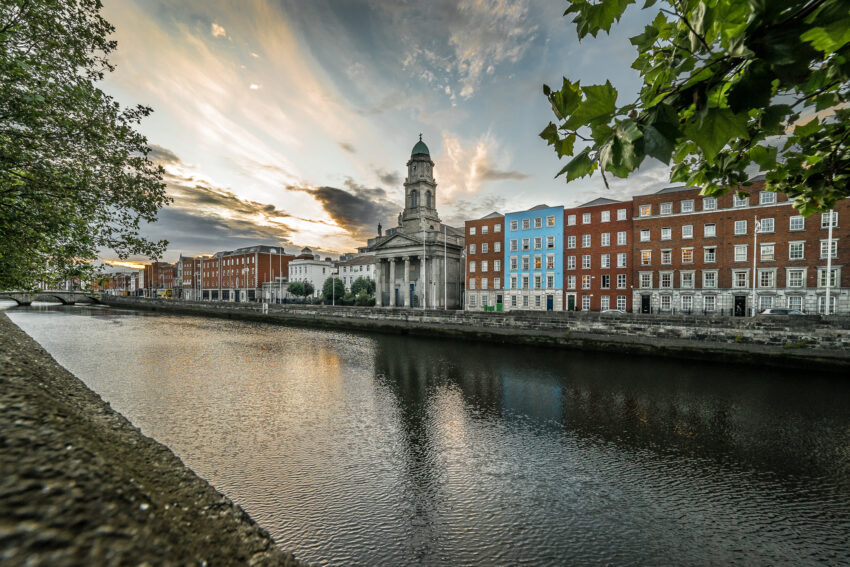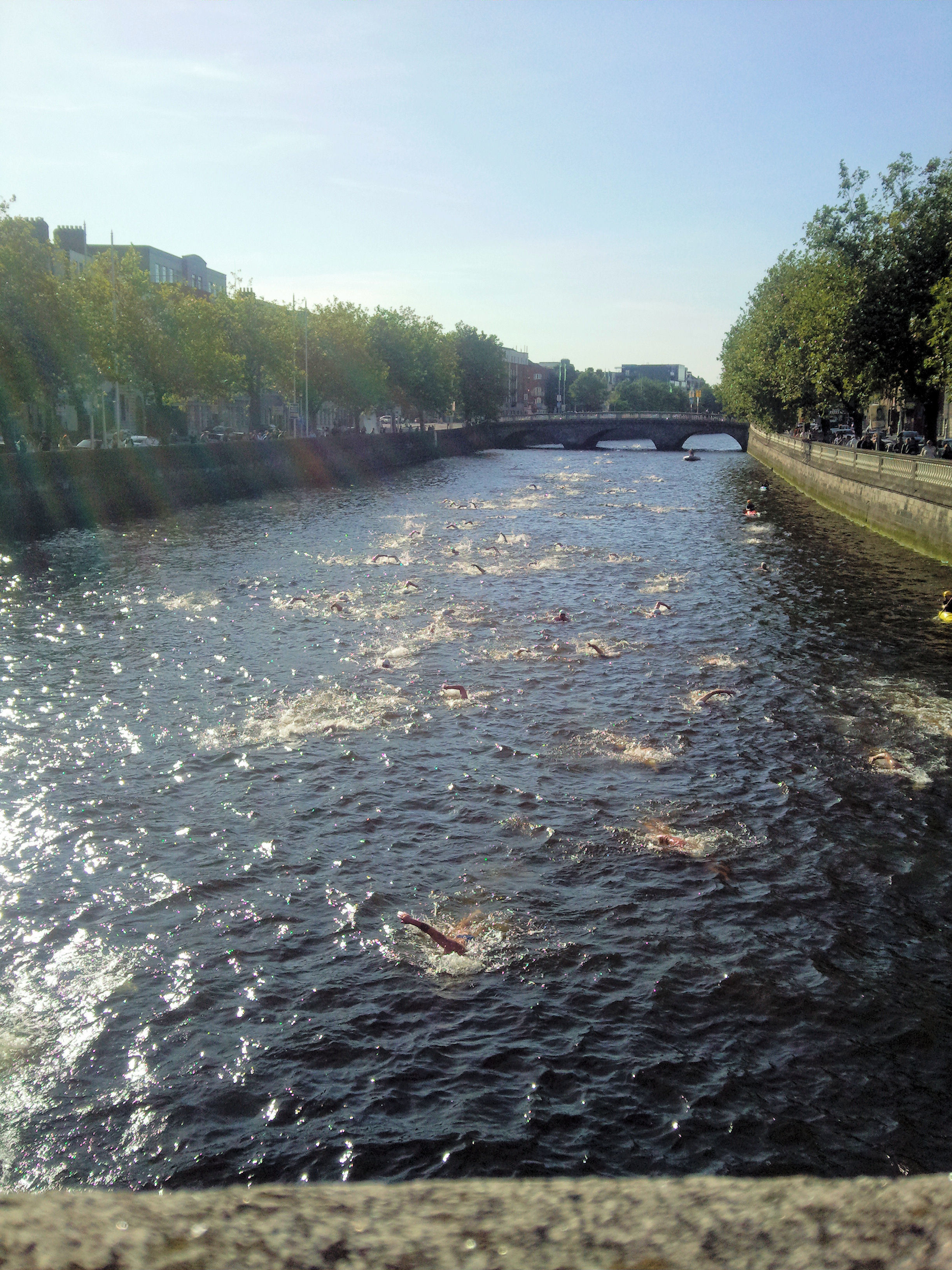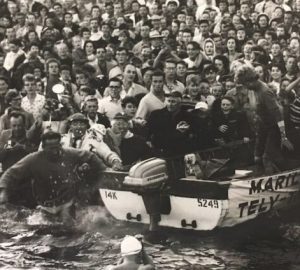The Liffey Swim turns 100
Dublin’s beloved open water offering turned 100 in 2019. Elaine Howley takes a look at the history of the Liffey Swim.
The early 20th century was a time of great upheaval around the world. As technology pushed out the boundaries of what was possible and the old ways of doing business faltered, new nations formed, global population exploded, and a world that in many ways looks a lot like our own began to take shape. It was a particular point in time – encompassing World War I, the vast social changes that followed it, and the run up to the Great Depression and World War II.
The early 20th century was also a time of intense transformation for Ireland. Though the Emerald Isle had long bridled under British rule, life on the island started to change as the 19th century gave way to the 20th. The National Archives of Ireland reports that in 1911, the so-called “second city of the British Empire, Dublin, was also the first city of nationalist Ireland and, within its boundaries, the divisions of class and culture were extraordinary.” Dublin was indeed a complex place, full of contradictions, diversity, and discord.
By 1919, rebellion had blossomed into revolution and a bloody struggle for Irish independence ensued. Though 1919 is considered the official start date of the Republic of Ireland’s successful bid for independence, much violence preceded the 1919 commencement and has lingered well beyond the official 1921 closing date of the war; tension remains even today.
Amid this churn and roil, arts and culture flourished in Dublin. A whole raft of writers who would go on to form a sturdy corner of the Western literary canon were hard at work, describing their daily lives and the people around them. Their visual art counterparts also captured the restive moment in a variety of media. Think a whole lot of Ulysses-like language with a healthy dose of insurrection and complete government upheaval thrown in for good measure.
Given all that was transpiring within the Fair City’s boundaries in 1920, it seems like perhaps that might have been an inauspicious time to launch a swimming contest. But that’s exactly what one city employee wanted to do.
Come on In, the Water’s Fine!
In 1920, Brendan Fagan, a swimmer and assistant public health analyst for Dublin Corporation, today known as the Dublin City Council, performed a chemical and bacteriological analysis of the Liffey River and found that the water was relatively clean, a strong statement for any urban waterway in the early 20th century. Eager to plunge in and show the river’s cleanliness to other Dubliners, Fagan mentioned his findings to Harry F Brennan, then Honorable Secretary of the Leinster Branch of the Irish Amateur Swimming Association, and Augustus J “Gus” Cullen, a fellow swimmer. An idea surfaced one evening as they crossed the Butt Bridge after a training session at the Tara Street Baths – what about hosting a swimming race through the heart of Dublin? It would show off how clean the water was and perhaps help bring more people to the sport of swimming.
“The idea of a swim through Dublin City as a means of popularising swimming struck a positive chord with Harry Brennan,” writes Cyril J Smyth, a retired Trinity College Dublin microbiology professor, in his detailed history of the Liffey Swim published by Leinster Open Sea, a nonprofit organisation that works with swimming clubs to establish a summer season of open sea races along the Leinster coast. Brennan brought his request to the city council, armed with Fagan’s data, and the council quickly approved the event.
Thus, on 22 July 1920, during high tide when the pollution level was a bit lower, 27 men launched from Victoria Quay at the Guinness Brewery gates (from a Guinness Barge) and swam down the Liffey to Burgh Quay. That first year, JJ “Jack” Kennedy won, and Fagan came third. (Fagan’s son Jack Fagan would go on to win the event in 1951.)
According to Smyth, “the event drew an estimated 20,000 to 100,000 spectators in its early years,” and in 1923, renowned painter Jack B Yeats, brother of the Nobel prize–winning writer William Butler Yeats, was among them, capturing the scene in oil and canvas. Yeats rendered the fluid energy of spectators cheering on swimmers as they glided past packed city streets in a powerful, expressionist image that would go on to win him an Olympic medal.

St Paul’s Church in Dublin. (Image (c) Guiseppe Milo)
That’s right. In addition to the sporting traditions we associate with the Olympics, from 1912 until 1948, art competitions were also part of the Olympic movement. At the 1924 Paris Games, medals were awarded in architecture, literature, music, painting, and sculpture to the best entries inspired by athletics. Yeats entered “The Liffey Swim” for judging and earned the Irish Free State’s first Olympic medal – a silver in the painting category. Winning swimmers today receive a print of Yeats’ painting as a prize.
A Dublin Tradition
From 1920 through 1935, the race became an annual fixture on the Dublin City summer calendar. But in 1936, health and safety concerns about water quality and pollution levels in the river forced the swim to move to Dollymount, a seaside location just northwest of Dublin. A decline in participation numbers sent the swim back to the Liffey in 1940.
Another eventual change centred around gender. Although there was “no specific rule debarring them,” as a letter to the sporting editor of the Irish Independent noted in 1922, women didn’t participate in the Liffey Swim. The writer argued that allowing women to swim would increase numbers and boost interest in the sport, pointing to other races down the River Lagan in Belfast and in London’s Thames as prime examples of women doing well in aquatic competition. When faced with the question of why women weren’t involved, a spokesperson for the Leinster IASA replied informally that “such a contest was not possible, as very few of our ladies were fit for the ordeal.”
There’s little doubt that women swimmers in the Liffey would have done just fine, as they had proved in many other venues around the world. But cultural norms of the day being what they were, it would take some time for women to be welcomed to the fold. After the 1932 race, Smyth reports, one Miss EM Kiersey wrote to the Irish Independent with the observation, “it seems strange that there has not so far been a Liffey swim for ladies.”
But calls for women to enter the race met strong resistance from many people, including the Most Reverend John Charles McQuaid, who served as Catholic Archbishop of Dublin and Primate of Ireland from December 1940 to February 1972, Smyth notes. McQuaid said men and women swimming together would be both “un-Catholic” and “un-Irish,” adding that “boys and girls should have a natural respect for one another. They would lose that respect through the familiarity bred on the athletic arena and in the conditions in which sports contests have to be conducted.”
He further equated keeping women out of the event with moral rectitude. “It is a Christian duty, incumbent on all of us, not to adopt what is morally wrong. God is not modern; nor is His Law……..Mixed athletics are a social abuse, outraging our rightful, national tradition.” He continued that “mixed athletics and all cognate immodesties are abuses that right-minded people reprobate wherever and whenever they exist.”

“I was only 12, and I think all I was ever told was, ‘put your head down and swim. Close your eyes and don’t look for the river rats,
Finally, in 1977, (McQuaid died in April 1973), the first Liffey Swim for women was staged. That first race was 500 yards long and Ann Cummins of the Cormorant S.C. came first. The women’s race ran again in 1978 and 1979, but then disappeared for several years, returning a few years later as the Upper Liffey Swim. It was still only 500 yards long and held on the same day, but well separate from the men’s main event. A fully equal race for women was only staged continuously beginning in 1991. Siobhán Hoare won that inaugural women’s swim.
However, in 1983, Elaine Burrows Dillane, 48, of Tralee was just 12 years old when she took the plunge. “I was a competitive swimmer when I was a teenager,” Burrows Dillane recalls, and in the course of her training made friends with a swimmer from Dublin whose family was very involved with the Liffey Swim. Piqued by this competitive friendship, she wanted to race, and entered her first open water event. She finished second. “I was only 12, and I think all I was ever told was, ‘put your head down and swim. Close your eyes and don’t look for the river rats,’ so it was easy to come second then!” she says with a laugh. “I got a prize of a watch, which I thought was brilliant,” she says, noting that she still has said watch and it still functions.
For her part, Burrows Dillane hasn’t done the swim again since. She drifted from the sport of swimming at age 19 when life intervened, but she says “I’ve always wanted to come back.” Finally, about four years ago, she heeded the encouragement of another friend and ventured back into open water. She’s since become the first woman to swim the 16 kilometres from Blennerville to Fenit in County Kerry. In July 2018, she completed a 21-kilometer swim from Blennerville to the Maherees on the northern coast of the Dingle Peninsula, another first among women.
At press time, Burrows Dillane was slated to swim the English Channel in September 2019, and says her return to swimming after so many years dry has been a wondrous journey. “I don’t know how I didn’t swim for so long. It’s brilliant to be back,” to a big part of herself that all can be traced back to the Liffey Swim.
Connecting Then to Now
Today, the swim still launches from Victoria Quay and passes under 12 bridges along its 2,200-metre journey, including the Rory O’Moore Bridge, the James Joyce Bridge, the Millennium Bridge, the Liffey Bridge (Ha’penny Bridge) and the Loop Line Bridge. Though the distance might not seem too daunting, the water can be very cold, typically ranging from 9 to 15 degrees C. Unlike most river swims, the Liffey Swim is considered an open sea race because swimmers battle an incoming tide in salty water. Swim starts are handicapped and men and women swim separately, but all are welcome these days – provided you can meet the stringent qualifying standards.
In 2019, the race, now formally titled the Jones Engineering Dublin City Liffey Swim, celebrated its 100th anniversary with some 600 swimmers participating in the centennial event on 3 August. Prior to the race, various entities commemorated the lengthy history of swimming down the Liffey. The Leinster Sea Swim Club staged a reenactment of the scene Yeats rendered in his medal-winning painting on 22 July 2019. And on 1 August, Ireland’s post office, An Post, released a commemorative €1 stamp featuring Yeats’ painting “The Liffey Swim.”
Dublin is the only European city that has a swimming race running right through the middle of it, and locals are proud of its strong tradition. Moreover, the plethora of evocative stories and portraits of swimmers that appeared throughout the media in the days leading up to the swim show not only how popular this event still is after so many years, but how the written word and visual representation of Dublin, its people, and its traditions are still central to Irish culture.
Irish or not, as many open water swimmers are well aware, the best adventures often develop out of a chat with a few friends after swim practice. Good thing Brendan Fagan, Harry Brennan and Gus Cullen felt the need to let other Dubliners in on their plans all those years ago.








